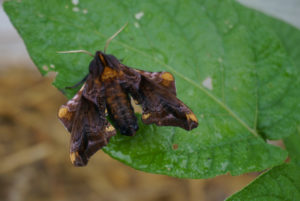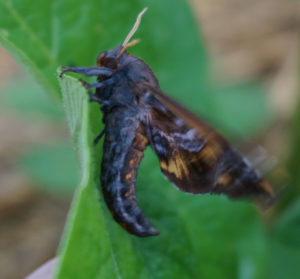Nature Reflections: Paonias myops – Small-eyed Sphinx
by D.E. Bentley –

The Sphinx moths have always caught my eye and attracted my attention – most notably the so called “hummingbird moths” that when feeding resemble, as the name suggests, hummingbirds. Since these moths move their wings so rapidly, seeing what they look like when still is rare, and a treat.
During a recent rainy morning, I encountered the Sphinx moth pictured above resting on the inside of a small plastic greenhouse structure we had erected in our garden area. Having not seen these moths still, I was not initially sure what it was but later identified it as a Paonias myops – also known as the Small-eyed Sphinx (J.E. Smith 1797).
Being a gardener, I am always curious about what various insects eat. Adult Small-eyed Sphinx moth caterpillars feed on black cherry, cherry, basswood and serviceberry vegetation – all of which are present in our area. Thankfully, their food needs rarely present a problem requiring intervention or controls. According to the information I found, the adults (moths) do not feed.
According to www.butterfliesandmoths.org, there have been reported sightings of Paonias myops across the United States, as well as into Canada and Mexico. Butterflies and Moths of North America is the online education site for the Butterflies and Moths of North America (BAMONA) project, “an ambitious effort to collect and provide access to quality-controlled data about butterflies and moths for the continent of North America from Panama to Canada. The project is hosted by the Butterfly and Moth Information Network and is directed by Kelly Lotts and Thomas Naberhaus”. Their goal is “to fill the needs of scientists and nature observers by bringing verified occurrence and life history data into one accessible location.”

The thirty-six pages of images of Paonias myops offered on the site showed a range of color variations, from tans to browns to more vibrant reds and blues. A number of the moths showed coloration similar to the one I photographed, with medium brown wings tinted with blues and yellow detailing. When the wings are closed, the moth’s coloration and shape resemble a leaf. When opened, the hind wings reveal a yellow patch enclosing a single black-rimmed eyespot. Since the moth I encountered was on the upper end of the size scale (1 3/4 – 2 15/16 inches) I concluded it was a female (since the females are often larger than their male counterparts).
As I watched the moth, water dripped from overhead onto her back. She grabbed the edge of a nearby potato leaf and curled her abdomen upward while extending her wings, vibrating them – presumably as a way of drying them. I left her there, perched on the leaf, as thunder rattled the darkening sky.